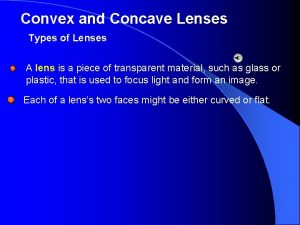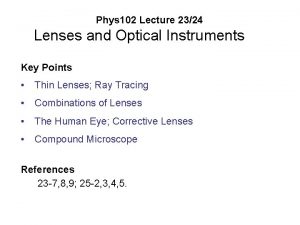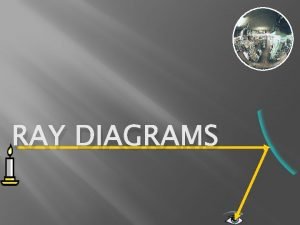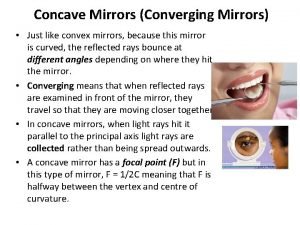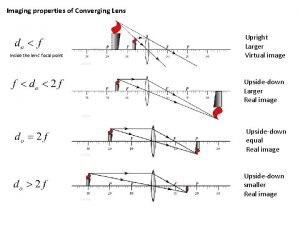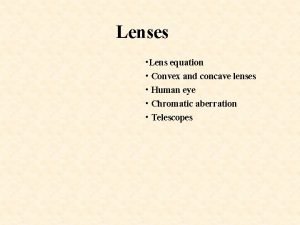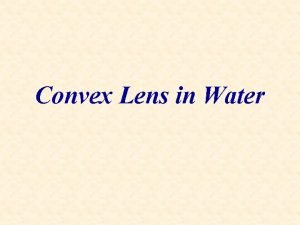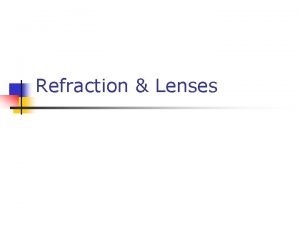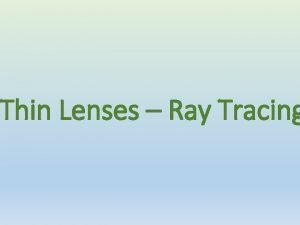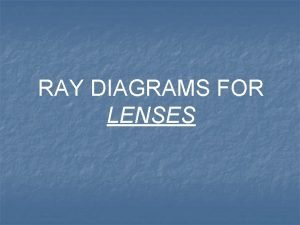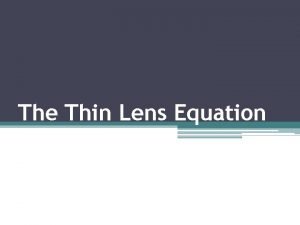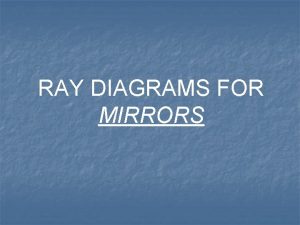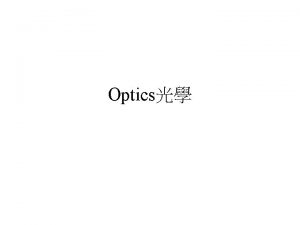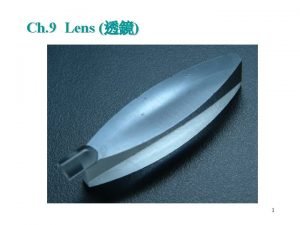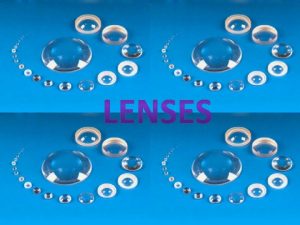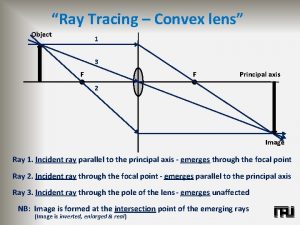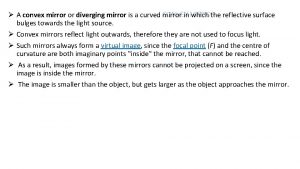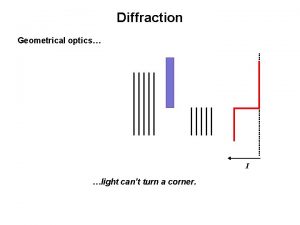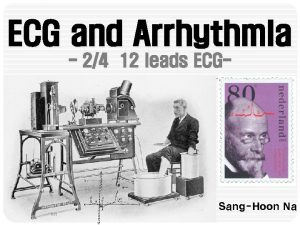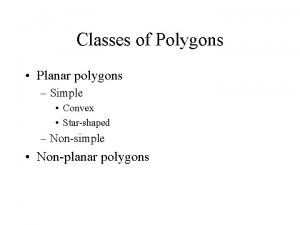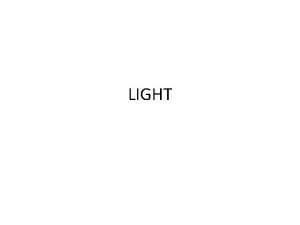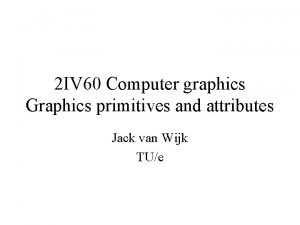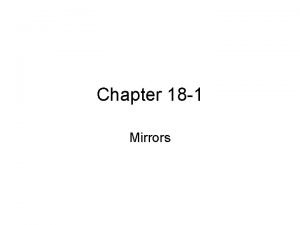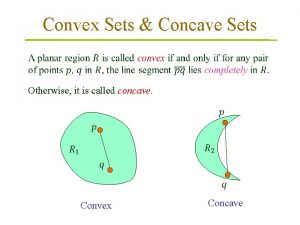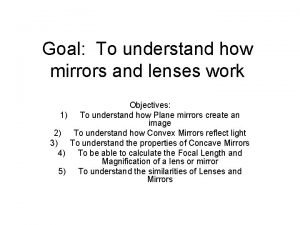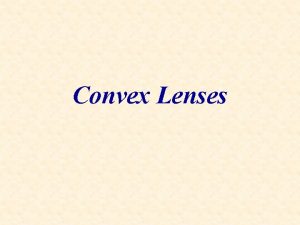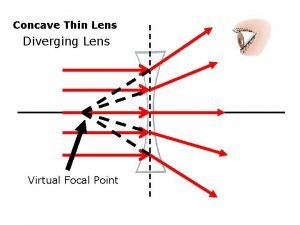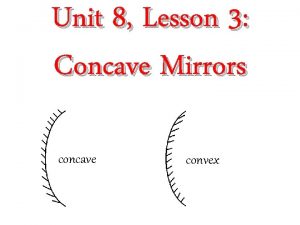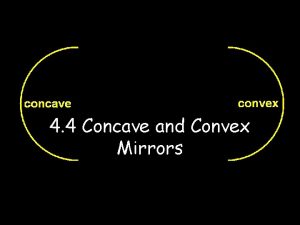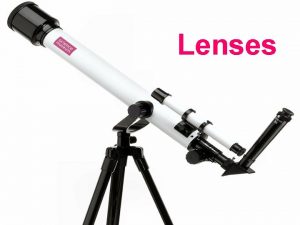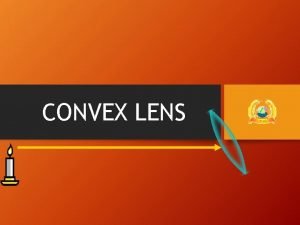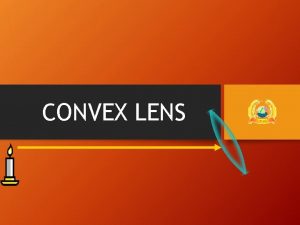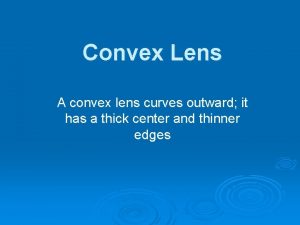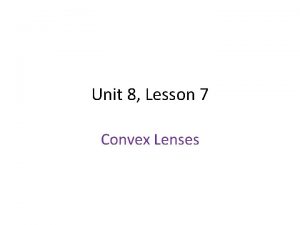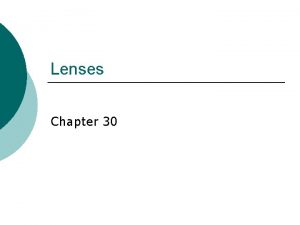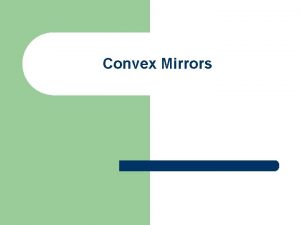RAY DIAGRAMS Diverging Lens Concave Converging Lens Convex


































- Slides: 34

RAY DIAGRAMS

Diverging Lens = Concave

Converging Lens = Convex

A ray of light is an extremely narrow beam of light.

All visible objects emit or reflect light rays in all directions.

Our eyes detect light rays.

We see images when light rays converge in our eyes. converge: come together

Mirrors It is possible to see images in mirrors. image object

Reflection (bouncing light ) normal Reflection is when light changes direction by bouncing off a surface. When light is reflected off a mirror, it hits the mirror at the same angle (the incidence angle, θi) as it reflects off the mirror (the reflection angle, θr). The normal is an imaginary line which lies at right angles to the mirror where the ray hits it. reflected ray incident ray θr θi Mirror

Lensmaker’s Equation ƒ = focal length do = object distance di = image distance if distance is negative the image is behind the mirror

Magnification Equation m = magnification hi = image height ho = object height If height is negative the image is upside down if the magnification is negative the image is inverted (upside down)

Refraction (bending light ) Refraction is when light bends as it passes from one medium into another. normal air θi When light traveling through air passes into the glass block it is refracted towards the normal. glass block θr When light passes back out of the glass into the air, it is refracted away from the normal. Since light refracts when it changes mediums it can be aimed. Lenses are shaped so light is aimed at a focal point. θi θr normal air

Lenses The first telescope, designed and built by Galileo, used lenses to focus light from faraway objects, into Galileo’s eye. His telescope consisted of a concave lens and a convex lens. light from object convex lens concave lens Light rays are always refracted (bent) towards the thickest part of the lens.

Rules for Concave Lens (Divergence) 1. 2. 3. An incident ray traveling parallel to the principal axis of a diverging lens will refract through the lens and travel in line with the focal point. An incident ray traveling towards the focal point on the way to the lens will refract through the lens and travel parallel to the principal axis. An incident ray that passes through the center of the lens will in affect continue in the same direction that it had when it entered the lens

Concave Lenses Concave lenses are thin in the middle and make light rays diverge (spread out). • F optical axis If the rays of light are traced back (dotted sight lines), they all intersect at the focal point (F) behind the lens.

Concave Lenses • F optical axis The light rays behave the same way if we ignore thickness of the lens. Light rays that come in parallel to the optical axis diverge from the focal point.

Concave Lenses • F optical axis Light rays that come in parallel to the optical axis still diverge from the focal point.

Concave Lens (example) • F optical axis The first ray comes in parallel to the optical axis and refracts from the focal point.

Concave Lens (example) • F optical axis The first ray comes in parallel to the optical axis and refracts from the focal point. The second ray goes straight through the center of the lens.

Concave Lens (example) • F optical axis The first ray comes in parallel to the optical axis and refracts from the focal point. The second ray goes straight through the center of the lens. The light rays don’t converge, but the sight lines do.

Concave Lens (example) • F optical axis The first ray comes in parallel to the optical axis and refracts from the focal point. The second ray goes straight through the center of the lens. The light rays don’t converge, but the sight lines do. A virtual image forms where the sight lines converge.

Your Turn (Concave Lens) object • F optical axis concave lens • Note: lenses are thin enough that you just draw a line to represent the lens. • Locate the image of the arrow.

Your Turn (Concave Lens) object • image F optical axis concave lens • Note: lenses are thin enough that you just draw a line to represent the lens. • Locate the image of the arrow.

Rules for Convex Lens (Convergence) 1. 2. 3. An incident ray traveling parallel to the principal axis of a converging lens will refract through the lens and travel through the focal point on the opposite side of the lens. An incident ray traveling through the focal point on the way to the lens will refract through the lens and travel parallel to the principal axis. An incident ray that passes through the center of the lens will continue in the same direction that it had when it entered the lens.

Convex Lenses Convex lenses are thicker in the middle and focus light rays to a focal point in front of the lens. The focal length of the lens is the distance between the center of the lens and the point where the light rays are focused.

Convex Lenses optical axis • F

Convex Lenses optical axis Light rays that come in parallel to the optical axis converge at the focal point. • F

Convex Lens (example) optical axis • F The first ray comes in parallel to the optical axis and refracts through the focal point.

Convex Lens (example) optical axis • F The first ray comes in parallel to the optical axis and refracts through the focal point. The second ray goes straight through the center of the lens.

Convex Lens (example) optical axis • F The first ray comes in parallel to the optical axis and refracts through the focal point. The second ray goes straight through the center of the lens. The light rays don’t converge, but the sight lines do.

Convex Lens (example) optical axis • F The first ray comes in parallel to the optical axis and refracts through the focal point. The second ray goes straight through the center of the lens. The light rays don’t converge, but the sight lines do. A virtual image forms where the sight lines converge.

Your Turn (Convex Lens) optical axis • F object image convex lens • Note: lenses are thin enough that you just draw a line to represent the lens. • Locate the image of the arrow.

Your Turn (Convex Lens) optical axis • F object image convex lens • Note: lenses are thin enough that you just draw a line to represent the lens. • Locate the image of the arrow.

Thanks/Further Info • Faulkes Telescope Project: Light & Optics by Sarah Roberts • Fundamentals of Optics: An Introduction for Beginners by Jenny Reinhard • PHET Geometric Optics (Flash Simulator) • Thin Lens & Mirror (Java Simulator) by Fu-Kwun Hwang
 Concave lens
Concave lens Near point distance
Near point distance Diverging lens example
Diverging lens example Salt for convex mirrors
Salt for convex mirrors Property of converging lens
Property of converging lens Macam macam rabun
Macam macam rabun Concave lens simulation
Concave lens simulation Convex lens in water
Convex lens in water Lens ray diagram
Lens ray diagram Lens ray tracing
Lens ray tracing Converging lens
Converging lens Magnification formula for lenses
Magnification formula for lenses Converging-diverging
Converging-diverging Function of economizer in boiler
Function of economizer in boiler Concave mirror ray diagram
Concave mirror ray diagram Object between f and lens
Object between f and lens Focal length formula
Focal length formula Image formation by convex lens
Image formation by convex lens Ray tracing convex lens
Ray tracing convex lens Convex mirror is a diverging mirror
Convex mirror is a diverging mirror Fraunhofer and fresnel diffraction
Fraunhofer and fresnel diffraction Concave vs convex ekg
Concave vs convex ekg Concave and convex polygon definition
Concave and convex polygon definition Elbow flexion 100 degrees
Elbow flexion 100 degrees Quadrilateral shape
Quadrilateral shape Concave vs convex light refraction
Concave vs convex light refraction Filled area primitives in computer graphics
Filled area primitives in computer graphics Spherical aberration in mirrors
Spherical aberration in mirrors Convex and concave
Convex and concave Polygons definition
Polygons definition Non convex polygon
Non convex polygon Grades of joint mobilization
Grades of joint mobilization Concave and convex mirror
Concave and convex mirror Concave vs convex hull
Concave vs convex hull Covex and concave
Covex and concave
